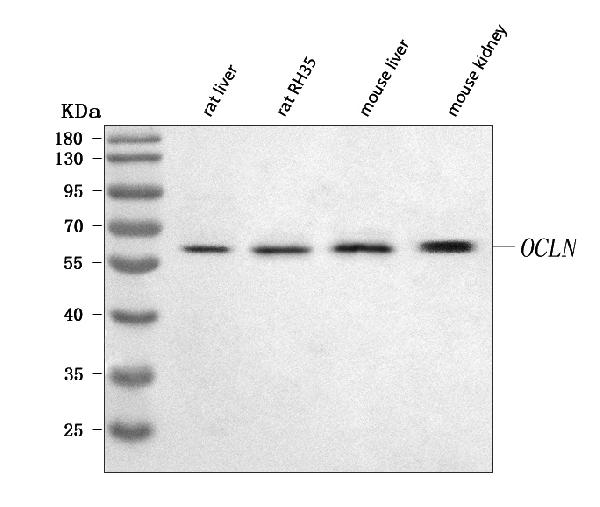Product Info Summary
| SKU: | A01246-3 |
|---|---|
| Size: | 100 µg/vial |
| Reactive Species: | Mouse, Rat |
| Host: | Rabbit |
| Application: | ELISA, WB |
Customers Who Bought This Also Bought
Product info
Product Name
Anti-Occludin/Ocln Antibody Picoband®
SKU/Catalog Number
A01246-3
Size
100 µg/vial
Form
Lyophilized
Description
Boster Bio Anti-Occludin/Ocln Antibody Picoband® catalog # A01246-3. Tested in ELISA, WB applications. This antibody reacts with Mouse, Rat. The brand Picoband indicates this is a premium antibody that guarantees superior quality, high affinity, and strong signals with minimal background in Western blot applications. Only our best-performing antibodies are designated as Picoband, ensuring unmatched performance.
Storage & Handling
At -20°C for one year from date of receipt. After reconstitution, at 4°C for one month. It can also be aliquotted and stored frozen at -20°C for six months. Avoid repeated freezing and thawing.
Cite This Product
Anti-Occludin/Ocln Antibody Picoband® (Boster Biological Technology, Pleasanton CA, USA, Catalog # A01246-3)
Host
Rabbit
Contents
Each vial contains 4 mg Trehalose, 0.9 mg NaCl, 0.2 mg Na2HPO4.
Clonality
Polyclonal
Isotype
Rabbit IgG
Immunogen
E.coli-derived mouse Occludin/Ocln recombinant protein (Position: E7-Y367).
*Blocking peptide can be purchased. Costs vary based on immunogen length. Contact us for pricing.
Cross-reactivity
No cross-reactivity with other proteins.
Reactive Species
A01246-3 is reactive to Ocln in Mouse, Rat
Reconstitution
Adding 0.2 ml of distilled water will yield a concentration of 500 µg/ml.
Observed Molecular Weight
59 kDa
Calculated molecular weight
59kDa
Background of Occludin
Occludin is an enzyme (EC 1.6) that oxidizes NADH. Predicted to enable protein domain specific binding activity. Involved in negative regulation of gene expression and tight junction organization. Located in several cellular components, including apical plasma membrane; apicolateral plasma membrane; and bicellular tight junction. Is expressed in several structures, including alimentary system; brain; genitourinary system; respiratory system; and sensory organ. Human ortholog(s) of this gene implicated in Crohn's disease and pseudo-TORCH syndrome 1. Orthologous to human OCLN (occludin).
Antibody Validation
Boster validates all antibodies on WB, IHC, ICC, Immunofluorescence, and ELISA with known positive control and negative samples to ensure specificity and high affinity, including thorough antibody incubations.
Application & Images
Applications
A01246-3 is guaranteed for ELISA, WB Boster Guarantee
Assay Dilutions Recommendation
The recommendations below provide a starting point for assay optimization. The actual working concentration varies and should be decided by the user.
Western blot, 0.25-0.5 μg/ml, Mouse, Rat
ELISA, 0.1-0.5 μg/ml, -
Positive Control
WB: rat liver tissue, rat RH35 whole cell, mouse liver tissue, mouse kidney tissue
Validation Images & Assay Conditions

Click image to see more details
Figure 1. Western blot analysis of Occludin/Ocln using anti-Occludin/Ocln antibody (A01246-3).
Electrophoresis was performed on a 5-20% SDS-PAGE gel at 70V (Stacking gel) / 90V (Resolving gel) for 2-3 hours. The sample well of each lane was loaded with 30 ug of sample under reducing conditions.
Lane 1: rat liver tissue lysates,
Lane 2: rat RH35 whole cell lysates,
Lane 3: mouse liver tissue lysates,
Lane 4: mouse kidney tissue lysates.
After electrophoresis, proteins were transferred to a nitrocellulose membrane at 150 mA for 50-90 minutes. Blocked the membrane with 5% non-fat milk/TBS for 1.5 hour at RT. The membrane was incubated with rabbit anti-Occludin/Ocln antigen affinity purified polyclonal antibody (Catalog # A01246-3) at 0.5 μg/mL overnight at 4°C, then washed with TBS-0.1%Tween 3 times with 5 minutes each and probed with a goat anti-rabbit IgG-HRP secondary antibody at a dilution of 1:5000 for 1.5 hour at RT. The signal is developed using an Enhanced Chemiluminescent detection (ECL) kit (Catalog # EK1002) with Tanon 5200 system. A specific band was detected for Occludin/Ocln at approximately 59 kDa. The expected band size for Occludin/Ocln is at 59 kDa.
Protein Target Info & Infographic
Gene/Protein Information For Ocln (Source: Uniprot.org, NCBI)
Gene Name
Ocln
Full Name
Occludin
Weight
59kDa
Superfamily
ELL/occludin family
Alternative Names
Cyclin-dependent kinase inhibitor 1C; Cyclin-dependent kinase inhibitor p57; p57Kip2; CDKN1C; KIP2 Ocln|AI503564, O, Ocl|occludin|occludin
*If product is indicated to react with multiple species, protein info is based on the gene entry specified above in "Species".For more info on Ocln, check out the Ocln Infographic

We have 30,000+ of these available, one for each gene! Check them out.
In this infographic, you will see the following information for Ocln: database IDs, superfamily, protein function, synonyms, molecular weight, chromosomal locations, tissues of expression, subcellular locations, post-translational modifications, and related diseases, research areas & pathways. If you want to see more information included, or would like to contribute to it and be acknowledged, please contact [email protected].
Specific Publications For Anti-Occludin/Ocln Antibody Picoband® (A01246-3)
Hello CJ!
No publications found for A01246-3
*Do you have publications using this product? Share with us and receive a reward. Ask us for more details.
Recommended Resources
Here are featured tools and databases that you might find useful.
- Boster's Pathways Library
- Protein Databases
- Bioscience Research Protocol Resources
- Data Processing & Analysis Software
- Photo Editing Software
- Scientific Literature Resources
- Research Paper Management Tools
- Molecular Biology Software
- Primer Design Tools
- Bioinformatics Tools
- Phylogenetic Tree Analysis
Customer Reviews
Have you used Anti-Occludin/Ocln Antibody Picoband®?
Submit a review and receive an Amazon gift card.
- $30 for a review with an image
0 Reviews For Anti-Occludin/Ocln Antibody Picoband®
Customer Q&As
Have a question?
Find answers in Q&As, reviews.
Can't find your answer?
Submit your question




